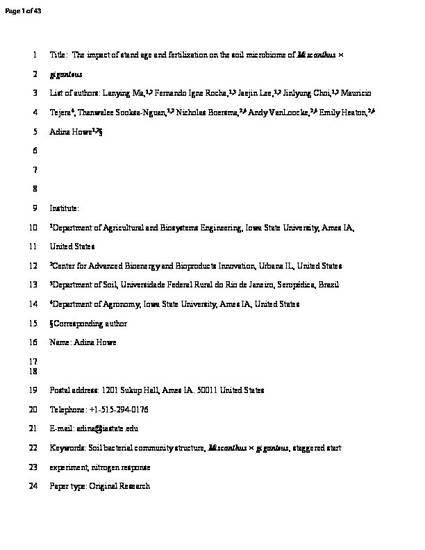
Yield of the perennial grass Miscanthus × giganteus has shown an inconsistent and unpredictable response to nitrogen (N) fertilizer, yet fertilization underpins the crop’s environmental and economic sustainability. The interactions among soil microbial communities, N availability, and Miscanthus × giganteus and management may explain changes in plant productivity. In this study, soil samples from different stand ages of Miscanthus × giganteus in a replicated chronosequence field trial were used to investigate the effects of stand age and N fertilizer rates on microbial community structure. We hypothesized that there is a definable Miscanthus × giganteus soil microbiome and that this community varies significantly with stand age and fertilization. Our results showed that the main phyla in soil microbial communities, regardless of plant age, are similar but microbial community structures are significantly different. The variation in observed microbial communities generally decreases with older stand ages. The amount of N fertilizer applied also affected the microbial community structure associated with different aged Miscanthus × giganteus. Specifically, the relative abundance of Proteobacteria (Alphaproteobacteria and Gammaproteobacteria) and Acidobacteria (subgroup Gp1) increased shortly after fertilization and was more associated with younger Miscanthus × giganteus. Furthermore, our results show a significant relationship between bacterial α diversity and fertilization rates and that this response is also affected by stand age. Overall, our results emphasize linkages between microbial community structure, plant age, and fertilization in Miscanthus × giganteus.
Available at: http://works.bepress.com/adina/45/

This article is published as Ma, Lanying, Fernando Igne Rocha, Jaejin Lee, Jinlyung Choi, Mauricio Tejera, Thanwalee Sooksa-Nguan, Nicholas Neal Boersma, Andrew Vanloocke, Emily Heaton, and Adina Howe. "The impact of stand age and fertilization on the soil microbiome of Miscanthus× giganteus." Phytobiomes Journal (2021). doi: 10.1094/PBIOMES-01-20-0014-FI.